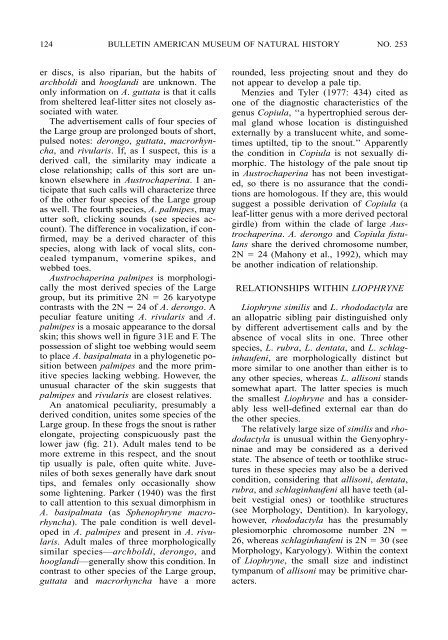SPHENOPHRYNE - American Museum of Natural History
SPHENOPHRYNE - American Museum of Natural History
SPHENOPHRYNE - American Museum of Natural History
You also want an ePaper? Increase the reach of your titles
YUMPU automatically turns print PDFs into web optimized ePapers that Google loves.
124 BULLETIN AMERICAN MUSEUM OF NATURAL HISTORY NO. 253<br />
er discs, is also riparian, but the habits <strong>of</strong><br />
archboldi and hooglandi are unknown. The<br />
only information on A. guttata is that it calls<br />
from sheltered leaf-litter sites not closely associated<br />
with water.<br />
The advertisement calls <strong>of</strong> four species <strong>of</strong><br />
the Large group are prolonged bouts <strong>of</strong> short,<br />
pulsed notes: derongo, guttata, macrorhyncha,<br />
and rivularis. If, as I suspect, this is a<br />
derived call, the similarity may indicate a<br />
close relationship; calls <strong>of</strong> this sort are unknown<br />
elsewhere in Austrochaperina. I anticipate<br />
that such calls will characterize three<br />
<strong>of</strong> the other four species <strong>of</strong> the Large group<br />
as well. The fourth species, A. palmipes, may<br />
utter s<strong>of</strong>t, clicking sounds (see species account).<br />
The difference in vocalization, if confirmed,<br />
may be a derived character <strong>of</strong> this<br />
species, along with lack <strong>of</strong> vocal slits, concealed<br />
tympanum, vomerine spikes, and<br />
webbed toes.<br />
Austrochaperina palmipes is morphologically<br />
the most derived species <strong>of</strong> the Large<br />
group, but its primitive 2N 26 karyotype<br />
contrasts with the 2N 24 <strong>of</strong> A. derongo. A<br />
peculiar feature uniting A. rivularis and A.<br />
palmipes is a mosaic appearance to the dorsal<br />
skin; this shows well in figure 31E and F. The<br />
possession <strong>of</strong> slight toe webbing would seem<br />
to place A. basipalmata in a phylogenetic position<br />
between palmipes and the more primitive<br />
species lacking webbing. However, the<br />
unusual character <strong>of</strong> the skin suggests that<br />
palmipes and rivularis are closest relatives.<br />
An anatomical peculiarity, presumably a<br />
derived condition, unites some species <strong>of</strong> the<br />
Large group. In these frogs the snout is rather<br />
elongate, projecting conspicuously past the<br />
lower jaw (fig. 21). Adult males tend to be<br />
more extreme in this respect, and the snout<br />
tip usually is pale, <strong>of</strong>ten quite white. Juveniles<br />
<strong>of</strong> both sexes generally have dark snout<br />
tips, and females only occasionally show<br />
some lightening. Parker (1940) was the first<br />
to call attention to this sexual dimorphism in<br />
A. basipalmata (as Sphenophryne macrorhyncha).<br />
The pale condition is well developed<br />
in A. palmipes and present in A. rivularis.<br />
Adult males <strong>of</strong> three morphologically<br />
similar species—archboldi, derongo, and<br />
hooglandi—generally show this condition. In<br />
contrast to other species <strong>of</strong> the Large group,<br />
guttata and macrorhyncha have a more<br />
rounded, less projecting snout and they do<br />
not appear to develop a pale tip.<br />
Menzies and Tyler (1977: 434) cited as<br />
one <strong>of</strong> the diagnostic characteristics <strong>of</strong> the<br />
genus Copiula, ‘‘a hypertrophied serous dermal<br />
gland whose location is distinguished<br />
externally by a translucent white, and sometimes<br />
uptilted, tip to the snout.’’ Apparently<br />
the condition in Copiula is not sexually dimorphic.<br />
The histology <strong>of</strong> the pale snout tip<br />
in Austrochaperina has not been investigated,<br />
so there is no assurance that the conditions<br />
are homologous. If they are, this would<br />
suggest a possible derivation <strong>of</strong> Copiula (a<br />
leaf-litter genus with a more derived pectoral<br />
girdle) from within the clade <strong>of</strong> large Austrochaperina.<br />
A. derongo and Copiula fistulans<br />
share the derived chromosome number,<br />
2N 24 (Mahony et al., 1992), which may<br />
be another indication <strong>of</strong> relationship.<br />
RELATIONSHIPS WITHIN LIOPHRYNE<br />
Liophryne similis and L. rhododactyla are<br />
an allopatric sibling pair distinguished only<br />
by different advertisement calls and by the<br />
absence <strong>of</strong> vocal slits in one. Three other<br />
species, L. rubra, L. dentata, and L. schlaginhaufeni,<br />
are morphologically distinct but<br />
more similar to one another than either is to<br />
any other species, whereas L. allisoni stands<br />
somewhat apart. The latter species is much<br />
the smallest Liophryne and has a considerably<br />
less well-defined external ear than do<br />
the other species.<br />
The relatively large size <strong>of</strong> similis and rhododactyla<br />
is unusual within the Genyophryninae<br />
and may be considered as a derived<br />
state. The absence <strong>of</strong> teeth or toothlike structures<br />
in these species may also be a derived<br />
condition, considering that allisoni, dentata,<br />
rubra, and schlaginhaufeni all have teeth (albeit<br />
vestigial ones) or toothlike structures<br />
(see Morphology, Dentition). In karyology,<br />
however, rhododactyla has the presumably<br />
plesiomorphic chromosome number 2N <br />
26, whereas schlaginhaufeni is 2N 30 (see<br />
Morphology, Karyology). Within the context<br />
<strong>of</strong> Liophryne, the small size and indistinct<br />
tympanum <strong>of</strong> allisoni may be primitive characters.
















